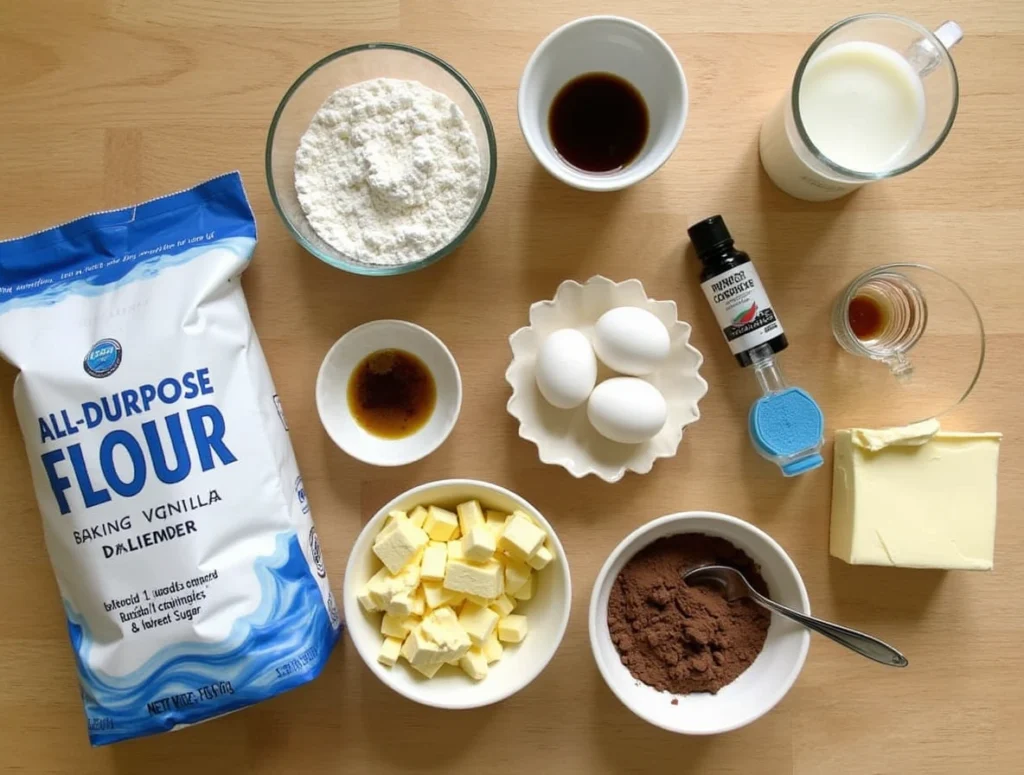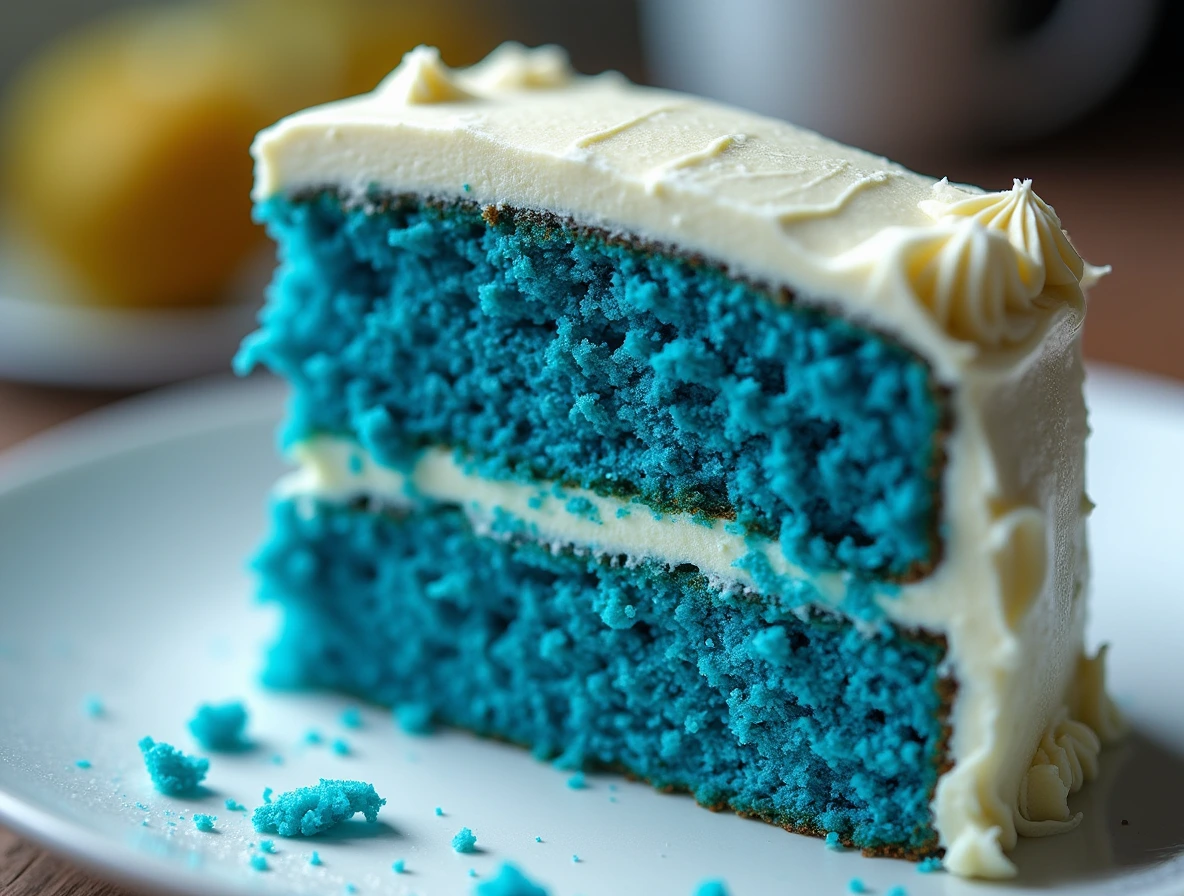Introduction
Blue velvet cake is a striking variation of the beloved red velvet cake, known for its soft texture, mild cocoa flavor, and vivid blue color. While the taste remains similar to its red counterpart, the deep blue hue makes it a stunning centerpiece for celebrations, baby showers, and patriotic events.
But what gives blue velvet cake its signature color and texture? Let’s explore the key ingredients, the science behind its fluffiness, and a step-by-step guide to baking the perfect cake.
If you love experimenting with colorful cakes, check out the history of velvet cakes to understand how this trend evolved!
Table of Contents
Origins of Blue Velvet Cake
The velvet cake family dates back to the 19th century, when bakers discovered that combining buttermilk and vinegar softened the gluten in flour, creating a tender crumb. Traditionally, red velvet cake became popular due to its subtle chocolate flavor and natural reddish tint from cocoa.
However, modern food coloring techniques paved the way for blue velvet cake, which swaps the red food dye for royal blue and violet hues. This cake remains fluffy, moist, and slightly tangy, making it a favorite among cake lovers.
To learn more about choosing the best food coloring, read this food coloring guide.

Key Ingredients in Blue Velvet Cake
1. Essential Cake Ingredients
The base of blue velvet cake is similar to red velvet cake, relying on a precise blend of ingredients:
- Cake Flour – Creates a lighter, more delicate crumb.
- Granulated Sugar – Sweetens and enhances moisture.
- Unsalted Butter – Adds richness and structure.
- Eggs – Help bind the cake together and add stability.
- Baking Soda & Salt – Act as leavening agents, ensuring a fluffy texture.
2. Unique Ingredients for Texture & Flavor
What makes a velvet cake stand out from regular cakes? These key ingredients:
- Buttermilk – The acidity softens the flour proteins, giving the cake a velvety texture.
- Cocoa Powder – A small amount adds a hint of chocolate flavor.
- White Vinegar – Reacts with baking soda to help the cake rise.
3. The Secret Behind the Blue Color
Achieving the perfect blue hue requires a specific mix of food colorings:
- Royal Blue Food Coloring – Forms the base color.
- A Tiny Bit of Violet Food Coloring – Prevents a greenish tint.
- Paste Food Coloring – Recommended over liquid or gel for a richer color.
How to Make Blue Velvet Cake
1. Preparation
- Preheat your oven to 350°F (175°C).
- Grease and flour two 9-inch round cake pans.
2. Mixing the Batter
- In a bowl, cream butter and sugar together until light and fluffy.
- Add eggs one at a time, mixing well after each.
- Stir in vinegar, vanilla extract, and food coloring.
- In another bowl, whisk together cake flour, cocoa powder, baking soda, and salt.
- Gradually add the dry ingredients to the wet mixture, alternating with buttermilk.
3. Baking the Cake
- Divide the batter evenly between the prepared pans.
- Bake for 20-25 minutes, or until a toothpick inserted in the center comes out clean.
- Let the cakes cool in the pans for 10 minutes, then transfer to a wire rack.
The Best Cream Cheese Frosting for Blue Velvet Cake
A blue velvet cake isn’t complete without a rich, creamy frosting!
Frosting Ingredients
- 8 oz cream cheese, softened
- ½ cup unsalted butter, softened
- 1 lb confectioners’ sugar
- 1 tsp vanilla extract
Instructions
- Beat the cream cheese and butter together until smooth.
- Gradually add in confectioners’ sugar, mixing well.
- Stir in vanilla extract and beat until fluffy.
For more frosting tips, read this guide on keeping cakes moist.
Tips for Achieving the Perfect Blue Velvet Cake
Want your cake to turn out flawless every time? Follow these expert tips:
- Use paste food coloring instead of liquid for a deeper blue.
- Measure ingredients accurately to avoid a dense cake.
- Don’t overmix the batter to keep the texture light.
- Cool cakes completely before frosting to prevent melting.
If you love baking, check out this guide on molten vs lava cake.
Frequently Asked Questions (FAQs)
A Comprehensive Guide to Blue Velvet Cake: Taste, Variations, and Storage Tips
Blue velvet cake is a visually stunning and delicious dessert that has gained popularity for its unique color and rich flavor. If you’ve ever wondered about its taste, how to make it, or how it differs from its red velvet counterpart, this guide will answer all your questions and more. Let’s dive into the world of blue velvet cake!
1. What Does Blue Velvet Cake Taste Like?
Blue velvet cake is known for its mild chocolate flavor, which is less intense than a traditional chocolate cake. The subtle cocoa taste is complemented by the richness of buttermilk, which adds a slight tanginess and moisture to the cake. The cream cheese frosting, a classic pairing for velvet cakes, brings a creamy, slightly tangy, and sweet balance to the dessert. Together, these elements create a harmonious blend of flavors that is both indulgent and satisfying. The texture is soft, velvety, and moist, making it a delightful treat for any occasion.
2. Can I Make Blue Velvet Cake Without Food Coloring?
Absolutely! While the signature blue hue is what makes blue velvet cake visually striking, the food coloring itself doesn’t contribute to the flavor. If you prefer to avoid food coloring, you can still make the cake using the same recipe. The result will be a delicious, mildly chocolate cake with a light brown or off-white color. It will taste just as good, but it won’t have the vibrant blue appearance. For a natural alternative, you can experiment with blue butterfly pea powder, though it may not achieve the same bold color as traditional food coloring.
3. What’s the Difference Between Blue Velvet and Red Velvet Cake?
The primary difference between blue velvet and red velvet cake lies in the food coloring used. Red velvet cake gets its iconic red color from red food dye, while blue velvet cake uses blue food coloring to achieve its striking shade. Beyond the color, the two cakes are nearly identical in terms of flavor and texture. Both feature a mild chocolate taste, buttermilk for tanginess, and cream cheese frosting. The choice between red and blue velvet often comes down to personal preference or the theme of an event.
4. Can I Substitute Buttermilk?
Yes, you can substitute buttermilk if you don’t have it on hand. Buttermilk is a key ingredient in velvet cakes because it adds moisture, tenderness, and a slight tang. To make a buttermilk substitute, mix 1 cup of regular milk with 1 tablespoon of vinegar or lemon juice. Let the mixture sit for about 5–10 minutes until it curdles slightly. This homemade buttermilk will work just as well in your blue velvet cake recipe. Alternatively, you can use plain yogurt or sour cream thinned with a little milk for a similar effect.
5. How Do I Store Blue Velvet Cake?
Proper storage is essential to keep your blue velvet cake fresh and delicious. Here are some tips:
- Room Temperature: If you plan to consume the cake within 1–3 days, store it in an airtight container at room temperature. Keep it away from direct sunlight or heat sources to prevent the frosting from melting.
- Refrigeration: For longer storage, refrigerate the cake in an airtight container or wrapped tightly in plastic wrap. It will stay fresh for up to a week. Let the cake come to room temperature before serving to restore its soft texture.
- Freezing: Blue velvet cake freezes well, making it a great make-ahead dessert. Wrap individual slices or the entire cake in plastic wrap and then in aluminum foil. Store it in the freezer for up to 2 months. Thaw the cake in the refrigerator overnight before serving.
6. Tips for Making the Perfect Blue Velvet Cake
- Use Gel Food Coloring: For a vibrant blue color, opt for gel food coloring instead of liquid. Gel coloring is more concentrated, so you’ll need less of it to achieve the desired shade.
- Don’t Overmix the Batter: Overmixing can lead to a dense cake. Mix the ingredients until just combined to ensure a light and fluffy texture.
- Balance the Frosting: Cream cheese frosting pairs perfectly with blue velvet cake, but make sure it’s not overly sweet. Adjust the sugar to your taste and ensure the frosting is smooth and spreadable.
- Decorate Creatively: Blue velvet cake is a showstopper, so have fun with decorations! Consider adding white chocolate shavings, edible glitter, or fresh berries for an extra touch of elegance.
7. Why Is Blue Velvet Cake So Popular?
Blue velvet cake has become a favorite for its eye-catching appearance and delightful flavor. It’s often chosen for themed parties, baby showers, or gender reveal events due to its vibrant color. The combination of mild chocolate, tangy buttermilk, and creamy frosting appeals to a wide range of palates, making it a crowd-pleaser. Plus, it’s a fun twist on the classic red velvet cake, offering a unique and memorable dessert option.
8. Can I Make Blue Velvet Cupcakes?
Yes, the blue velvet cake recipe can easily be adapted to make cupcakes. Simply pour the batter into lined cupcake tins and bake for about 18–20 minutes, or until a toothpick inserted into the center comes out clean. Top with cream cheese frosting and enjoy bite-sized versions of this delicious dessert. Cupcakes are perfect for parties or as a portable treat.
9. Is Blue Velvet Cake Suitable for Special Diets?
With a few adjustments, blue velvet cake can be made to accommodate special diets. For a gluten-free version, use a gluten-free flour blend. To make it dairy-free, substitute the buttermilk with a plant-based milk mixed with vinegar and use dairy-free cream cheese for the frosting. For a vegan option, replace the eggs with flax eggs or another egg substitute. Always check the labels of your ingredients to ensure they meet your dietary needs.
Conclusion
Blue velvet cake is a show-stopping dessert that’s as delicious as it is beautiful. With its moist texture, subtle chocolate flavor, and rich blue color, it’s perfect for any special occasion. Whether you’re baking for a celebration or just treating yourself, this cake is sure to impress!
For more delicious cake recipes, check out this guide on the difference between molten and lava cake.


1 thought on “What Is Blue Velvet Cake Made Of? A Complete Guide”